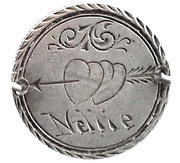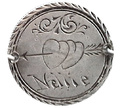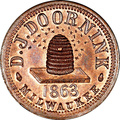
Harley J. Spiller is one of the most voracious collectors in the United States, but you won’t find him wandering around the tony galleries of Christie’s in New York or tromping through the antiques-strewn fields of Brimfield, Massachusetts. That’s because Spiller collects things like seashells, bottle caps, Chinese menus, paperclips, photographs of corn, and “furcula,” which most of us know as wishbones. Spiller has around 80 collections of such modest objects, which are usually easier to stumble upon serendipitously than to seek out by design.
“If you rub the shoulders of Ben Franklin’s coat, you can feel the raised lines.”
Even Spiller’s collections of traditional collectibles such as coins and paper currency are amassed for what can only be described as Spillerian reasons. Spiller only collects coins that are mangled or severely degraded in appearance, paper currency that’s been defaced—the stuff, in other words, that no self-respecting numismatist would give a second glance.
In a recent interview about his first book, Keep the Change: A Collector’s Tale of Lucky Pennies, Counterfeit C-Notes, and Other Curious Currency (Princeton Architectural Press, 2015), Spiller told me how he got into this understandably neglected corner of currency collecting. “By looking at coins and bills through the cockeyed lens of mutilation,” Spiller says, “I had the area to myself. Nobody wanted it. It was a way to have my own Picasso collection, if you will.”

Top: “Comedy & Tragedy,” 2013, by Mark Wagner, from the collection of Harley J. Spiller. Above: “One Dollar Bill (Silver Certificate),” 1962, by Andy Warhol, via Sotheby’s.
The “Picassos” in Spiller’s currency collection include munched quarters, verdigrised pennies, and dollar bills worn almost to the point of illegibility. What caught my eye, though, in Keep the Change was the chapter on currency that has been transformed into pocket-size works of art.

A mangled quarter from the collection of Harley J. Spiller.
In fact, money and art have long been something of a mutual admiration society. Andy Warhol painted his “One Dollar Bill (Silver Certificate)” in 1962 because, he quipped, money was the thing he loved the most—a few weeks ago, that painting sold for more than $32 million at Sotheby’s in London. Beginning in the 1960s, Ed Kienholz rubber-stamped words like “For $264” on sheets of watercolor paper, thus combining the object’s price tag with its content. Fellow Los Angeleno Chris Burden got even more conceptual in 1977 with “Diecimila,” a high-quality photo-etching of a 10,000 Italian lire note (the one with Michelangelo on it), meticulously printed front-and-back in a small edition of 35 by Crown Point Press. The printing was so good, the artwork could have been cut out and passed off as currency, which was actually the late artist’s joke—at the time, a scissored “Diecimila” would have been worth about $6, making Burden’s signed piece of paper far more valuable than its inspiration from the Bank of Italy.

“For $264,” 1974, by Edward & Nancy Reddin Kienholz, via L.A. Louver Gallery.
Numerous artists are featured in Keep the Change, but Spiller seems to have special admiration for artists Mark Wagner and J.S.G. Boggs. Wagner uses paper currency like a raw material, cutting it up to produce elaborate portrait collages or defacing a bill so subtly that it probably could be passed as legal tender (see “Comedy & Tragedy,” 2013, at top). Boggs produces hand-drawn riffs on U.S. paper money (as works of art, they are not technically forgeries). Each artist is highly regarded in the art world and so potentially difficult to reach, but Spiller encountered them almost as casually as the pelican furcula he picked up one day on a Florida beach.
“In preparation for writing the book, I put out an open call for artists who alter money,” Spiller recalls. “Someone I know through the Museum of American Finance, where I work, forwarded my open call to Mark Wagner, who responded. I went to an opening and met him. He was very nice, very sympatico. Later, I wrote him to ask how much one of his pieces would cost, so I could buy one and put it in the book, even though his work is way out of my price range. But he didn’t want to go into prices. He said, ‘Maybe we could trade something. I like the way you write, and I can’t seem to get a Wikipedia entry.’ So I traded him a Wikipedia entry. He gave me the ‘Comedy & Tragedy’ bills for that.”

“Diecimila,” 1977, by Chris Burden, via Crown Point Press.
Like Spiller, Mark Wagner also appreciates currency for its craftsmanship and beauty. “The new hundred is almost mind-bogglingly complex,” says Spiller. “Mark says it’s the finest quality engraving being done in the world today. It’s got micro-printing that you need a magnifying glass to read, and if you rub the shoulders of Ben Franklin’s coat, you can feel the raised lines. It doesn’t necessarily hang together as a work of art the way the $2 silver certificates do, but that’s because it has so many anti-counterfeiting features. Of those, my favorite is the blue polymer ribbon with micro-lenses in it that dance and move. It’s woven through the front of the bill, only. I defy you to go into your closet and find a piece of clothing with stitches just through the front. It’s an amazing thing.”
Spiller’s connection to Boggs goes back further, but is just as straightforward. “I called Boggs out of the blue,” Spiller remembers of his first contact with the elusive artist in the late 1990s. “I was teaching an after-school program for third, fourth, and fifth graders in Tribeca. Boggs was in the phonebook down in Florida so I dialed his number and asked him to be a guest instructor. He agreed, but when I asked his fee, he answered ‘$17.’ I said, ‘How did you arrive at that number?’ and he said, ‘You said there were 17 children in the class. I want one bill drawn by each child.’”

“Bedroom I’s,” 1994, by J.S.G. Boggs.
As Spiller recounts in Keep the Change, Boggs was very good at getting the kids to think beyond an object’s appearances, which is in no small part what his art is about:
Boggs came to New York and started his lesson by drawing a picture on the chalkboard and asking the students, “What is it?”
“A dog?”
“No.”
“A dog sitting down?
“No.”
“A beagle?”
“No.”
“A bear?”
“No.”
This went on for fifteen minutes, until Boggs elicited the answer he sought:
“A picture of a dog.”
Then he asked, “What’s a dollar worth?”
“Four quarters?”
“No.”
“Ten dimes?”
“No.”
Another fifteen minutes elapsed before a child said, “I’d shovel snow for an hour to get a dollar.” Boggs’s Socratic method made everyone in the room realize that money is only a symbol—that dollars are worth different things to each of us.

Some very bad pennies from the collection of Harley J. Spiller.
By all accounts, the hobby of currency collecting could use a lot more people like J.S.G. Boggs if it wants to remain relevant to young people. Spiller knows this from firsthand experience with his 6-year-old son, whom he recently tried to introduce to coin collecting, with mixed results.
“I went to a bourse, which is a gathering for the sale and inspection of currency, at the Museum of American Finance,” Spiller says. “There were going to be a lot of youngsters there, so I brought my son. I gave him a new state quarter’s book and three state quarters. He was into it, and I snapped a photo of him holding a magnifying glass and just gleaming, really digging it. That afternoon, though, the book went in a drawer, and it hasn’t come out since.”

 An Interview with Smithsonian Coin and Currency Curator Richard Doty
An Interview with Smithsonian Coin and Currency Curator Richard Doty
 Darling, Can You Spare a Dime? How Victorians Fell in Love With Pocket Change
Darling, Can You Spare a Dime? How Victorians Fell in Love With Pocket Change An Interview with Smithsonian Coin and Currency Curator Richard Doty
An Interview with Smithsonian Coin and Currency Curator Richard Doty During the Civil War, Some People Got Rich Quick By Minting Their Own Money
During the Civil War, Some People Got Rich Quick By Minting Their Own Money Andy WarholAndy Warhol’s work is like a joke: Either you get it or you don’t. For some…
Andy WarholAndy Warhol’s work is like a joke: Either you get it or you don’t. For some… US Paper MoneyCollectors of U.S. paper money have a rich array of notes and certificates …
US Paper MoneyCollectors of U.S. paper money have a rich array of notes and certificates … US CoinsCoins have always held a special place in the American psyche. Early on, Th…
US CoinsCoins have always held a special place in the American psyche. Early on, Th… Mari Tepper: Laying it on the Line
Mari Tepper: Laying it on the Line Nice Ice: Valerie Hammond on the Genteel Charm of Vintage Canadian Costume Jewelry
Nice Ice: Valerie Hammond on the Genteel Charm of Vintage Canadian Costume Jewelry How Jim Heimann Got Crazy for California Architecture
How Jim Heimann Got Crazy for California Architecture Modernist Man: Jock Peters May Be the Most Influential Architect You've Never Heard Of
Modernist Man: Jock Peters May Be the Most Influential Architect You've Never Heard Of Meet Cute: Were Kokeshi Dolls the Models for Hello Kitty, Pokemon, and Be@rbrick?
Meet Cute: Were Kokeshi Dolls the Models for Hello Kitty, Pokemon, and Be@rbrick? When the King of Comedy Posters Set His Surreal Sights on the World of Rock 'n' Roll
When the King of Comedy Posters Set His Surreal Sights on the World of Rock 'n' Roll How One Artist Makes New Art From Old Coloring Books and Found Photos
How One Artist Makes New Art From Old Coloring Books and Found Photos Say Cheese! How Bad Photography Has Changed Our Definition of Good Pictures
Say Cheese! How Bad Photography Has Changed Our Definition of Good Pictures Middle Earthenware: One Family's Quest to Reclaim Its Place in British Pottery History
Middle Earthenware: One Family's Quest to Reclaim Its Place in British Pottery History Fancy Fowl: How an Evil Sea Captain and a Beloved Queen Made the World Crave KFC
Fancy Fowl: How an Evil Sea Captain and a Beloved Queen Made the World Crave KFC
This is an Australian artist/group that ‘re-face’ money but unfortunately haven’t uploaded anything new for a while
https://bunchof5s.wordpress.com/
Fascinating article! Fabulous artist! Thank you!
those are some cool counterfeit bills
$3.00 Barack Obama bill
How do I post a photo in your Show & Tell gallery